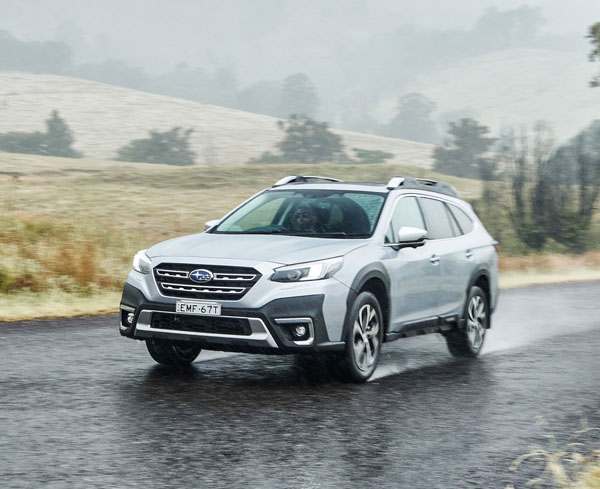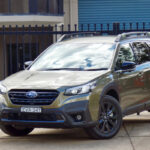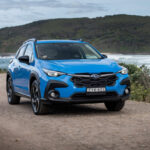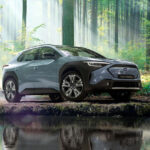
With Liberty’s departure, Outback is now flagship of the Subaru range — but not the most
expensive. That dubious honour goes to the hard-edged, high-performance version of the
WRX sporty — the STI spec.R.
But I know which one I’d rather have. My wife reckons the latest Outback is a corker too.
About the only thing missing is a third row of seats. In fact, there’s no seven-seater in the
entire Subaru range which is a bit strange — not since the Tribeca people mover in 2013.
We drove the bare bones Outback a few weeks back. This time we’re enjoying a tilt in the
top of the range Touring model. Which begs the question: is it worth an extra $8140?
STYLING
More like a wagon than high-riding SUV, Outback has continued to evolve over the years,
getting better and better with each outing.
There are three grades and even the entry Outback is well equipped, priced from $39,990
plus on-roads. Next up is the Sport priced from $44,490, followed by top of the range
Touring from $47,790 — or an advertised $52,928 driveaway.
They all get the same engine, transmission and wheels.
Subaru has done the right thing too and standardised safety systems across the board,
apart from a side view monitor for the Sport and Touring grades. The Touring model ups
the ante with minor cosmetic differences, leather instead of cloth trim, dual zone climate air
with rear air vents, rear privacy glass and auto power up for all windows.
There’s also 18-inch alloys, push-button start, auto lights and wipers, auto dimming mirror,
auto high beam, rear park sensors, self-levelling, daytime LEDs, steering-responsive LED
headlights and adaptive cruise control.

Other differences include a sunroof, power tailgate, heated steering wheel, heated seats
front and back, power adjustment for both front seats, with dual memory for the driver’s
seat, auto dipping side mirror, and the icing on the cake, the nine-speaker harman/kardon
sound with subwoofer and amplifier.
INTERIOR
Without a third row of seats, the cabin is spacious and comfortable, with leather and
heating front and back, not to mention a heated steering wheel — but alas no cooling for
the front seats.
The big touchscreen is impressive, and this model does come with built-in satellite
navigation. You can also hook up your phone to navigate, but as seems to be the norm,
our phone would not connect to Android Auto at first and when it did, the system refused
to cooperate until the vehicle came to a stop.
The big portrait style screen can be configured to show one large portrait-shaped huge
map, or tiers of information — map at the top, audio and air controls below.
The drivers instrument cluster is old school with two analogue dials separated by a small
info panel where speed can be displayed digitally and the speed limit is shown.
We’re big fans of the large, physical blind spot warning lights that never fail to capture
attention.

INFOTAINMENT
There’s a nine-speaker harman/kardon sound system. Don’t know about you, but I reckon
you can’t spend too much on car audio.
The car is a place you spend a lot of time and a large percentage of this is spent listening
to music.
The huge 11.6-inch portrait style touchscreen brings satellite navigation and a CD player
this time around, along with DAB+ digital radio, Carplay and Android Auto, with 2 x 12v
and 2 x USB ports.
ENGINES / TRANSMISSIONS
The four-cylinder direct injection boxer layout delivers 138kW of power and 245Nm of
torque, the latter from 3400-4600 rpm — about 7 per cent more power and 4 per cent more
torque than before.
It’s paired with a continuously variable auto, with a greater spread of ratios for improved
take-off and better fuel economy.
The transmission comes with paddle shifts and 8-speed manual mode, as well as sport
and intelligent drive modes.
SAFETY
Safety includes eight airbags, a reverse camera and the latest generation EyeSight Driver
Assist system, with Lane Centering Function and Autonomous Emergency Steering.
There’s also Emergency Lane Keep Assist, and Lane Departure Warning with steering
wheel vibration.
Lane Departure Prevention and Pre-Collision Braking System, with expanded support for
collision avoidance at intersections are also fitted, along with Speed Sign Recognition with
Intelligent Speed Limiter,
Vision Assist includes Blind Spot Monitor (BSM), Lane Change Assist (LCA), Rear Cross
Traffic Alert (RCTA), Reverse Automatic Braking (RAB), and EyeSight Assist Monitor.
DRIVING
As mentioned previously, all grades are powered by the same 2.5-litre naturally aspirated
four-cylinder petrol engine.
The diesel has gone to heaven and there’s no word yet on a hybrid, which has already
found its way into XV and Forester.
Subaru claims the flat four is 90 per cent new and like the BRZ, it seems to be better than
the figures suggest.
Drive is to all four wheels, but only part of the time.
Although described as Symmetrical all-wheel drive, it is in fact an active split system with
torque distributed between front and rear wheels as required. In short, it remains front-
wheel drive most of the time.
Dual function X-MODE offers set-and-forget throttle control in mud, snow and steep
unsealed surfaces, with 213mm of ground clearance, and active torque vectoring that
brakes individual wheels to maintain control during cornering.
Auto Stop-Start now incorporates “Change of Mind Control” which as its name suggests,
restarts the engine within 0.2 of a second — if you change your mind.
Suspension is Mac strut at front and double wishbones at the back and it rides on 18-inch
wheels with 225/60 series rubber, with a full-size spare.
Shame about the diesel which offered 350Nm of torque, but it is what it is and for the most
part, performance is fine.
It’s only when you become demanding and punch the accelerator, that you’re reminded it’s
a four — and a naturally aspirated one at that.
Subaru has access to turbocharged units and very good ones, which have the potential to
replace low end torque. So, why it didn’t opt for one of these is mystifying?
Bear in mind too, that maximum torque, in this case 245Nm, is produced from 3400-4600
revs — which means it needs a few revs to get going.
In its quest for torque, the CVT transmission makes the car sound tinny and raucous, with
the noise that makes these style trannies objectionable.
At other times, in fact most of the time, the drive experience is just right, with a cabin that
is quiet and ride that is super smooth.
With a 63-litre tank, it takes standard 91 unleaded and like the previous model is rated at
7.3L/100km.
We were getting 9.3L/100km (base model used 8.1L).
Also, it can tow a 2000kg braked load, with a maximum 200kg on the towball (it was
previously rated at 1500kg).
SUMMING UP
Is the extra $8000 grand worth it? I don’t think it is, at least not when you put it that way.
But at $52,928 driveaway, with this level of safety, built-in sat nav and premium
harman/kardon sound, there’s no more to spend. The Outback Touring model is worth
every cent.
AT A GLANCE
MODEL RANGE
Outback AWD: $39,990
Outback AWD Sport: $44,490
Outback AWD Touring: $47,790
Note: These prices do not include government or dealer delivery charges. Contact your
local Subaru dealer for drive-away prices.
SPECIFICATIONS (Subaru Outback AWD Touring, 8sp CVT)
ENGINE:
Capacity: 2.5 litres
Configuration: Horizontally-opposed Boxer 4-cylinder, petrol engine
Maximum Power: 138 kW @ 5800 rpm
Maximum Torque: 245 Nm @ 3400-4600 rpm
Fuel Type: Unleaded petrol (91 RON or higher)
Combined Fuel Cycle (ADR 81/02): 7.3L/100km
CO2 Emissions: 168 g/km
DRIVELINE: Lineartronic Continuously Variable Transmission with 8-step manual mode,
all-wheel drive
DIMENSIONS, WEIGHT AND CAPACITIES:
Length: 4870 mm
Wheelbase: 2745 mm
Width: 1875 mm
Height: 1675 mm
Turning Circle: 11.0 metres
Kerb Mass: 1661 kg
Fuel Tank Capacity: 63 litres
BRAKES:
Front: Ventilated disc
Rear: Ventilated disc
STANDARD WARRANTY:
Five years / Unlimited kilometres
RATINGS:
Looks: 7.5/10
Performance: 7/10
Safety: 8.5/10
Thirst: 7.0/10
Practicality: 8/10
Comfort: 8/10
Tech: 8.5/10
Value: 8.5/10
Overall: 7.9/10












they have too little torque now for any kind of spirited driving (overtaking without worry etc). Both 350 Nm motors have gone – the diesel and the 3.6/six cyl.
With this in mind I traded my old 2010 3.6 for a 2019 3.6 while I could. The 3.6 mates with the CVT better too. Using S# mode and/or paddles really makes the car spirited in this form. Not sure how well it goes with the 2.5 motor but I’m hearing it’s “just OK”
I guess this will be our last Outback because of the engine. Besides, EVs will be very viable by the time we need to change cars again.
I have not yet discovered why this new generation of Outback doesn’t get the option of the 2.4 turbocharged motor that is available in the States. It virtually mimics (or even slightly betters) the performance of the outgoing 3.6.
Very probably a supply problem with the world going through this crazy last 2 years